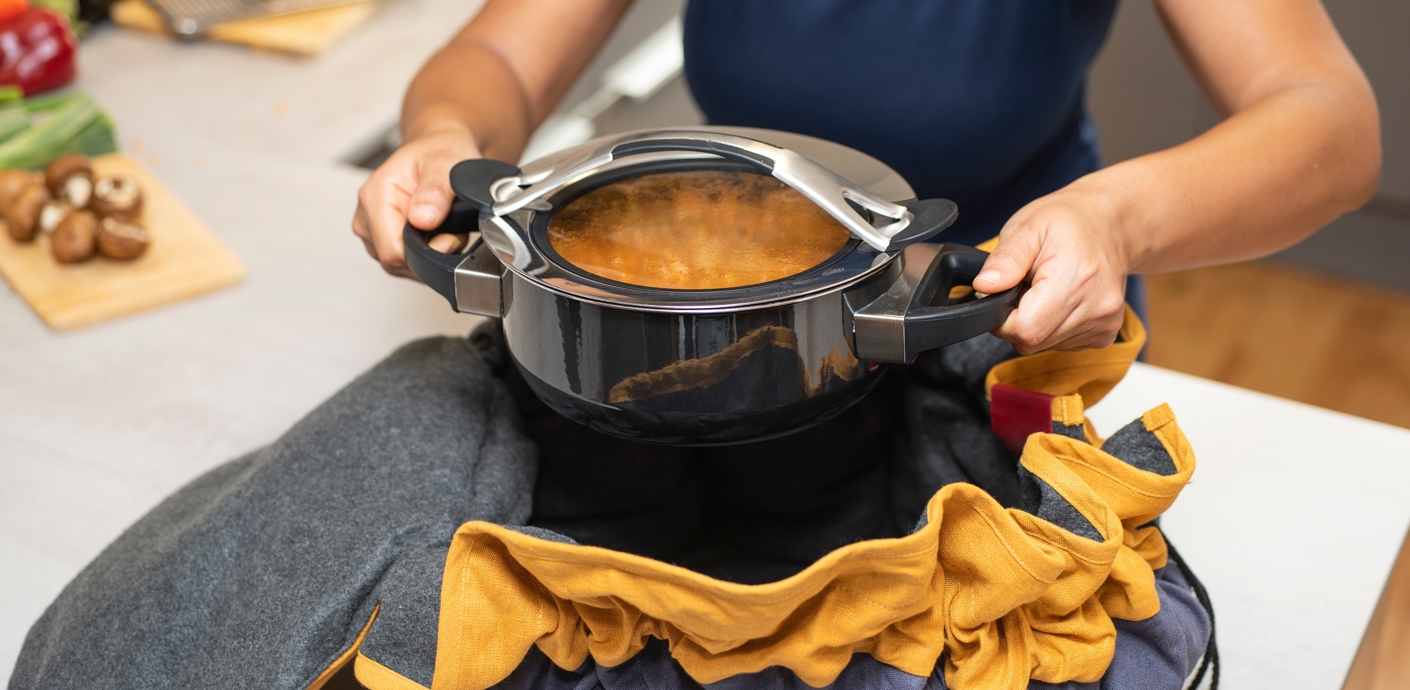DIY thermal cookers
Save on energy and get good at batch cooking by making a thermal cooker.

What is a thermal cooker?
A thermal cooker is an insulated bag or box that retains heat so that your food continues to cook after it is removed from the heat, without using further energy. You may have also heard it called a hay box, or under the brand name Wonderbag™ .
It's ideal for foods cooked in liquid such as stews, soups, curries, chilli or rice. It is also good for bulk cooking dried lentils, beans and pulses which can be frozen for future use. You can also use it to keep food cold.
How do I get a thermal cooker?
You can buy a ready-made bag or you can make one yourself with any spare fabric you have. Use an insulated box such as a cool box. You can even use a cardboard box and surround your hot cooking pot with insulation such as cushions, an old sleeping bag or duvet.
Thermal cooking tips
-
Ensure your pot or casserole is suitable for heating on a hob, fire or in a microwave. You need to heat the pot and contents thoroughly before transferring to your thermal cooker to finish cooking. Generally, the contents need to be covered with a liquid.
-
To retain heat well your pot needs to be full so consider this when choosing what size pot to use. You can make extra portions and freeze some for another day to fill your pot if you need to. A cast iron casserole, whilst not essential, is very effective at retaining heat. You could look out for one in charity shops or at car boot sales.
-
Make sure your pot is well covered with insulation – if using a bag type thermal cooker do the bag up as tightly as you can. Lining your bag with towels adds extra insulation as well as protecting against spills. Place the pot on a trivet or folded towel to avoid burning the bottom of the bag. If using a box, ensure your pot is fully covered.
-
When cooking lentils, beans and pulses (if not canned which are already cooked) avoid tomato based sauces and leave adding salt to the end as tomatoes and salt can hinder softening.
Liquid won’t boil away once the food is in the thermal cooker so if using a recipe designed for the hob or oven you may want to reduce the amount of liquid.
-
For food safety it is important that once cooked, the temperature of hot food doesn’t fall below 61 degrees C for more than 2 hours. Use a food thermometer to check the temperature, at least the first few times, until you have a feel for how long your thermal cooker retains heat effectively.
Find more information about food cooking safety.
Find out more about thermal cookers
For guides about how to make and use a thermal cooker see the Facebook group Wonderbag and Hay Box Cooking UK.
Simple vegetable curry recipe
Ingredients
- A mix of chopped vegetables such as sweet potato, cauliflower, broccoli, carrot, potato, green beans.
- One onion, chopped.
- One clove garlic, crushed or chopped.
- Approx 2cm cubed ginger, peeled and sliced.
- 1 green chilli, sliced.
- 400g tin of chickpeas or other beans, drained and rinsed.
- A couple of tomatoes, chopped, or a can of tomatoes.
- Coconut milk - either one can or the powdered sort diluted in hot water.
- Vegetable stock if more liquid is needed to cover everything- you can just use water.
- One teaspoon of chilli flakes or powder.
- One teaspoon of turmeric.
- One teaspoon of cumin.
- One teaspoon of ground coriander.
- Salt and pepper to taste.
Method
- In a tight lidded casserole safe for using on the hob, heat a little oil and fry the onion for a few mins till it is starting to soften.
- Add the garlic, ginger and chilli and continue stirring for a minute, then add the other spices and stir in to release the flavour.
- Next add the rest of the vegetables, coconut milk, canned tomatoes (if using) and stock – you want enough liquid to just cover all the vegetables, and enough vegetables for your pot to be full.
- Stir well and bring to the boil, cover tightly with the lid.
- Boil for 15 mins to make sure it is really hot.
- Transfer carefully to your thermal cooker and seal it up tightly.
- Get on with something else and come back to it up to 4 hours later (but as it is all vegetables 1-2 may suffice).
- Open it carefully – remember it will still be hot.
